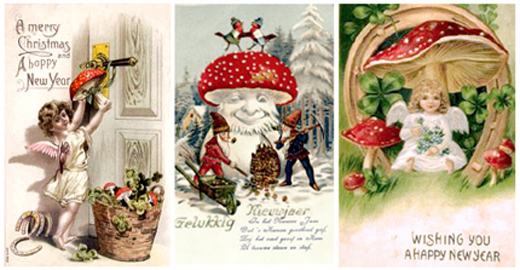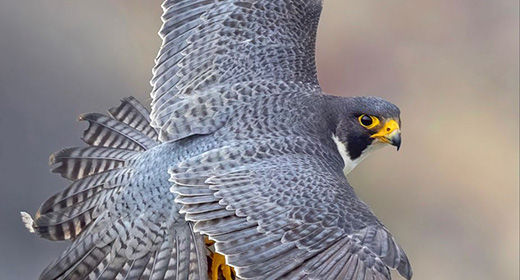by Melanie Xulu: It’s that time of year again! People won’t stop banging on about the John Lewis Christmas advert,

‘late night shopping’ is doing your head in, and you’ve probably eaten your body weight in mince pies and chocolate selection boxes…
Whilst many of us celebrate this strange tradition, it turns out, it’s probably a little stranger than we thought…Have you ever wondered why Father Christmas wears a red and white suit? Why we wrap our presents in red and white wrapping paper, or why we hang red and white bauballs on our tree? You get the gist, there’s a definite red & white colour scheme going on…Yes, urban legend has it that Santa himself and his red and white outfit, was designed by Coca Cola in the late Victorian period as a massive ad campaign, and while this may be partially true, there is some evidence that points to the fact that the somewhat blurred origins of Mr. Claus may have emerged, pre-Coca Cola, from Siberian shamanism and the use of the Amanita Muscaria, a red and white spotty hallucinogenic mushroom, in their shamanic practices.

The image of Santa Claus, and our Christmas traditions have been around for hundreds if not thousands of years, and can be traced right back to pre-Christian times, with its roots deep in Paganism, and Nordic mythology. The period around the 25th December has always been one of celebration, a time, more often than not, that included large banquets, music, dancing, and in general – a coming together of sorts. The lives of ancient people were controlled by seasons and the harvest cycle, winter was tough – it was dark, cold, and immensely difficult, many people died during the season. So celebration was needed to keep spirits high and to stay positive during the grueling winter months. The harvest would have been brought in during the autumn, the cattle would have been slaughtered so they wouldn’t have to be fed during the winter, and the majority of wine and beer made during the year would have finally fermented and been ready for drinking – this meant there was an abundance of food and drink, which may explain the frequent banqueting during the winter.
The Vikings had the ancient Midwinter festival, Yule, which occurred in Nordic countries between the Winter Solstice (21st December) and the Jólablót (Yule Sacrifice), which originally may have happened on the 12th of January. This period was a time of feasting, banquets, games, drinking, song, and sacrifice to the gods. The Romans had the festival of Saturnalia, an ancient festival in honour of the god Saturn, held on the 17th of December through to the 23rd if December. The holiday was celebrated with a sacrifice at the Roman Temple of Saturn, then a public banquet, followed by private gift-giving and general Roman raucous. Other celebrations occurred throughout Europe, with similar themes of banqueting/feasting, gift-giving, human sacrifice – all things that have carried on, and still occur today in the holiday season – well, apart from the sacrifice – hopefully.

The significance of mistletoe and holly around Christmas time, also goes back thousands of years; Peter Haining in his book, ‘Superstitions’, wrote, “The mistletoe, was revered by the ancient Greeks as sacred, yet superstition has it that the reason why it is so lucky to be kissed under it is that the plant once offended the old Gods, who thereafter condemned it to have to look on while pretty girls were being kissed.” In many pre-Christian cultures, holly was associated with the god of winter, it was also the sacred plant of Saturn and was used at the Roman festival of Saturnalia to honor him. Romans gave one another holly wreaths and carried them about, decorating them with images of Saturn.
The ancient druids used to wear sprigs of holly in their hair when they went into the forest to cut sprigs of mistletoe from the branches of oak trees, they’d do this with a golden sickle on the sixth night of the new moon after the winter solstice. A cloth was held below the tree by other members of the order to catch the sprigs of mistletoe as they fell, as it was believed that it would have profaned the mistletoe to fall upon the ground. The chief druid would then divide the branches into many sprigs and distribute them to the people, who hung them over doorways as protection against thunder, lightning and other evils. They also believed it had strong sexual powers, and, boiled with the blood of a pair of sacrificial white bulls, it would make the best aphrodisiac. According to the Anglo-Saxons, kissing under the mistletoe was connected to the legend of Freya, the goddess of love and fertility. Legend has it, a man had to kiss any young girl who, without realizing it, found herself accidentally under a sprig of mistletoe hanging from the ceiling.
Even the origins of Christmas caroling are hundreds of years old, stemming from the medieval tradition of wassailing (from the Anglo-Saxon Waes Hael), something that still happens in the crooks and crannies of the English and Scottish countryside today. House-visiting wassailers (not to be confused with the orchard wassail) would go from door to door, singing and drinking to the health of their neighbors. The concept harks back to pre-Christian fertility rites where villagers traveled through fields and orchards in the middle of winter, singing and shouting to drive away any spirits that might effect the growth of future crops.

Around the year 280AD, the figure of Saint Nicholas, a fourth-century Greek bishop and gift-giver of a Christian community in the ancient town of Myra, begins to emerge. As the story goes, he was brought up in a wealthy family, lost both of his parents as a young man, and used his inheritance to help the poor and sick. He famously is said to have helped the poor father of three marriageable daughters who could not afford their dowries. To save them from a life of prostitution, which was a common fate for unmarried women in the third century, he dropped three sacks of gold down their father’s chimney late one night, making him the patron saint of prostitutes – probably don’t tell that one to your kids on Christmas Eve.
As for magic mushrooms? Well they’ve been around for donkey’s years too, and have been used for spiritual and recreational purposes for thousands of years, with their use documented as far back as 9000 B.C. in North African indigenous cultures, based on representations in rock paintings. An archaeological image found on a cave in Tassili, Algeria, dating back to 3500 B.C. details mushrooms with animated auras surrounding dancing shamans, and there is also a well-known depiction of mushrooms in a cave in Spain which dates back 6-8 thousand years, among other ancient depictions around Europe. In fact, a recent molecular study proposed that the Amanita Muscaria had ancestral origins in the Siberian–Beringian region during the Tertiary period (65 million to 2.58 million years ago), before spreading out across Asia, Europe and North America.

So how do mushrooms relate to Santa Claus? Siberian shamans? What’s this all about? Well, Siberian shamans used to dress to resemble that of the Amanita Muscaria, and, according to some sources, female shamans originally wore red and white costumes trimmed with white fur, black boots, and felt red hats. To this day, Siberian mushroom gatherers go out in a ceremonial red and white outfit to honour the colour of the mushrooms they pick. Red hat, red suit trimmed with white fur, black boots…Remind you of anyone?

Prof. John Rush, author of ‘Mushrooms in Christian Art‘, and professor of anthropology at Sierra College in Rocklin, California, has researched the subject heavily, “Santa is a modern counterpart of a shaman, who consumed mind-altering plants and fungi to commune with the spirit world”, he says, “as the story goes, up until a few hundred years ago these practicing shamans or priests connected to the older traditions would collect Amanita muscaria (the Holy Mushroom), dry them, and then give them as gifts on the winter solstice.”

The shaman would collect the mushrooms, which grow almost exclusively under pine trees, in a large sack, and would often use an opening in the roof to deliver his gifts, as the vast amount of snow would block the door. During Siberian winters, the snow piles up past the doors of the villagers’ yurts, so the red and white clad shaman must climb down the chimney to deliver the presents in his sack. Once the shaman has done the rounds of delivering the Amanita Muscaria, the villagers string the mushrooms up or put them in bags hung in front of the fire to dry. As well as this, when mushroom gatherers would go out and pick the mushrooms they would often place them on the leaves of the trees in the forest to dry them out in the sun.
We could easily draw comparisons from this to our modern day tradition of decorating the Christmas tree with shiny red and white ornaments, to hanging stockings full of gifts in front of the fire, and the imagery of Santa with his sack going down the chimney.
“So, why do people bring Pine trees into their houses at the Winter Solstice, placing brightly colored (Red and White) packages under their boughs, as gifts to show their love for each other and as representations of the love of God and the gift of his Sons life? It is because, underneath the Pine bough is the exact location where one would find this ‘Most Sacred’ Substance, the Amanita muscaria, in the wild.” -James Arthur, “Mushrooms and Mankind” (8)
It’s a modern-day tradition in many parts of Northern Europe to decorate the Christmas tree with ornaments of mushrooms
According to Carl Ruck, a professor at Boston University, reindeer are the spirit animals of the shaman. Many indigenous people of Norway, Sweden, Finland, and parts of Russia have a close relationship with the animal. Most notably, the Sami, who inhabit Lapland – the northernmost region of Finland, often said to be the geographical location of Santa Claus and his elves. Reindeer husbandry is an important aspect of Sami culture, in Norway and Sweden reindeer husbandry is legally protected as an exclusive Sami livelihood, and only people of Sami descent with reindeer herding family ancestry can own reindeer.
So why are the reindeer on our Christmas cards often shown flying? Well, because Dancer, Prancer, Vixen, Blitzen, and Rudolph are off their faces on magic mushrooms….obviously. Research has shown that reindeer do in fact have a fondness for the Amanita Muscaria. Deputy editor of the Pharmaceutical Journal, Andrew Haynes, wrote in 2010 that animals deliberately seek out the red and white spotted mushroom in their habitats, as they “have a desire to experience altered states of consciousness” Haynes also wrote, “for humans, a common side-effect of mushrooms is the feeling of flying, so it’s interesting the legend about Santa’s reindeer is they can fly.”According to The Sun, Haynes even claimed that reindeer seek out the mushrooms to “escape the monotony of dreary long winters.”

Haynes also said that Shamans and herdsmen drink the reindeer urine to experience the high themselves, which is apparently where the term ‘to get pissed’ comes from. After much debate about this, it turns out to be quite true. According to an account by Andy Letcher, who spent some time living with the Sami, his hosts started feeding reindeer hallucinogenic mushrooms, which the deer consumed happily. They then collected the urine, boiled it up in a pot, and shared it around. Letcher said in an interview, “I don’t drink and I’ve never taken any drugs…But I took some when they passed it round. Well, you have to, don’t you? They expect it. Anyway, I was high as a kite…”
As well as this, Philip Johann von Strahlenberg, a Swedish prisoner of war in the early eighteenth century, reported seeing Koryak tribes-people waiting outside huts where ‘mushroom sessions’ were taking place, waiting for people to come out and urinate. When they did, it was collected in wooden bowls and drunk.. The hallucinogenic effect of the Amanita Muscaria could apparently be recycled up to five times in this manner. He published his account in 1730, in ‘An Historical and Geographical Description of the North and Eastern Parts of Europe and Asia, Particularly of Russia, Siberia, and Tartary’
 According to some, including Jack Herer, hemp activist and author of ‘The Emperor Wears No Clothes‘, Santa Claus was a magic mushroom, an Amanita Muscaria, Fly Agaric, trippy toadstool, call it what you will – nothing more nothing less. Maybe Herer was smoking too much hash when he came out with that one, but it might make some sense that the image of Santa is inspired by the red and white spotted fungi. Believe it or not, Santa wasn’t the only mushroom; Dead Sea Scrolls scholar, and author of the infamous ‘The Sacred Mushroom and the Cross’, John Allegro, famously claimed Jesus was a mushroom, and that Christianity was the product of an ancient “sex-and-mushroom” cult, with the word “Christ” apparently being some sort of ancient Sumerian word that meant “A mushroom covered in God’s semen.”…but that’s an article for another day.
According to some, including Jack Herer, hemp activist and author of ‘The Emperor Wears No Clothes‘, Santa Claus was a magic mushroom, an Amanita Muscaria, Fly Agaric, trippy toadstool, call it what you will – nothing more nothing less. Maybe Herer was smoking too much hash when he came out with that one, but it might make some sense that the image of Santa is inspired by the red and white spotted fungi. Believe it or not, Santa wasn’t the only mushroom; Dead Sea Scrolls scholar, and author of the infamous ‘The Sacred Mushroom and the Cross’, John Allegro, famously claimed Jesus was a mushroom, and that Christianity was the product of an ancient “sex-and-mushroom” cult, with the word “Christ” apparently being some sort of ancient Sumerian word that meant “A mushroom covered in God’s semen.”…but that’s an article for another day.
 Reindeer, chimneys, pine trees, a sack full of gifts, presents under the tree, the red and white colour scheme, there are so many similarities one could make between our modern day Santa Claus, our Christmas traditions, and the ancient Siberian shamanistic mushroom rituals. The origins of Christmas, and Santa Claus, branch off into different beliefs and areas – Siberian shamanism and the Amanita Muscaria being a branch on the Christmas tree, if you will, among different branches including the Christian St. Nicholas, Paganism, Nordic mythology, Anglo-Saxon tradition, Roman festivities, and so on and so forth, all these branches connect to the roots of Christmas, it’s very beginnings – which stem from pre-Christian beliefs and early Winter Solstice rituals and practices.
Reindeer, chimneys, pine trees, a sack full of gifts, presents under the tree, the red and white colour scheme, there are so many similarities one could make between our modern day Santa Claus, our Christmas traditions, and the ancient Siberian shamanistic mushroom rituals. The origins of Christmas, and Santa Claus, branch off into different beliefs and areas – Siberian shamanism and the Amanita Muscaria being a branch on the Christmas tree, if you will, among different branches including the Christian St. Nicholas, Paganism, Nordic mythology, Anglo-Saxon tradition, Roman festivities, and so on and so forth, all these branches connect to the roots of Christmas, it’s very beginnings – which stem from pre-Christian beliefs and early Winter Solstice rituals and practices.
So, no, Santa Claus might not have literally been a magic mushroom, but you could argue the Amanita Muscaria had an influence on the creating of the character of Santa Claus, as well as some of our modern-day Christmas rituals. Next time you put your red and white wrapped Christmas presents under your Christmas pine tree, hang the red and white stockings out in front of the fire, or find yourself singing “Rudolph The Red-Nose Reindeer”, try not to think of hallucinogenic reindeer wee.
Have yourself a very merry psychedelic Christmas. With love from all at MOOF xxx

MOOF claims no credit for any images posted on this site unless otherwise noted. If there is an image appearing on this blog that belongs to you and you do not wish for it appear on this site, please E-mail with a link to said image and it will be promptly removed











































